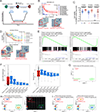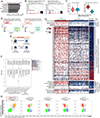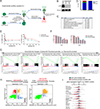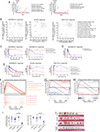An Embryonic Diapause-like Adaptation with Suppressed Myc Activity Enables Tumor Treatment Persistence
- PMID: 33417832
- PMCID: PMC8670073
- DOI: 10.1016/j.ccell.2020.12.002
An Embryonic Diapause-like Adaptation with Suppressed Myc Activity Enables Tumor Treatment Persistence
Abstract
Treatment-persistent residual tumors impede curative cancer therapy. To understand this cancer cell state we generated models of treatment persistence that simulate the residual tumors. We observe that treatment-persistent tumor cells in organoids, xenografts, and cancer patients adopt a distinct and reversible transcriptional program resembling that of embryonic diapause, a dormant stage of suspended development triggered by stress and associated with suppressed Myc activity and overall biosynthesis. In cancer cells, depleting Myc or inhibiting Brd4, a Myc transcriptional co-activator, attenuates drug cytotoxicity through a dormant diapause-like adaptation with reduced apoptotic priming. Conversely, inducible Myc upregulation enhances acute chemotherapeutic activity. Maintaining residual cells in dormancy after chemotherapy by inhibiting Myc activity or interfering with the diapause-like adaptation by inhibiting cyclin-dependent kinase 9 represent potential therapeutic strategies against chemotherapy-persistent tumor cells. Our study demonstrates that cancer co-opts a mechanism similar to diapause with adaptive inactivation of Myc to persist during treatment.
Keywords: CDK9; CRISPR; MYC; adaptation to stress; breast cancer; cancer; diapause; drug persistence; prostate cancer; residual tumor.
Copyright © 2020 Elsevier Inc. All rights reserved.
Conflict of interest statement
Declaration of Interests E.D. and C.S.M. are co-inventors on a patent related to the use of 3D cultures. Y.C. reports personal fees from Oric Pharmaceuticals outside the submitted work. R.J. reports research funding from Pfizer and Lilly and consulting for Carrick and Luminex. M.B. reports sponsored research support from Novartis; serves on the science advisory board (SAB) of and received fees from Kronos Bio, GV20 Oncotherapy, and H3 Biomedicine; and holds equity in Kronos Bio and GV20 Oncotherapy. N.S.G. is a founder, SAB member, and equity holder in Gatekeeper, Syros, Petra, C4, Allorion, Jengu, Inception, B2S, and Soltego (board member) and his lab receives or has received research funding from Novartis, Takeda, Astellas, Taiho, Jansen, Kinogen, Her2llc, Deerfield, and Sanofi. C.S.M. discloses research funding from Janssen/Johnson & Johnson, Teva, EMD Serono, Abbvie, Arch Oncology, Karyopharm, Sanofi, and Nurix; employment of a relative with Takeda; and consultant/honoraria from Fate Therapeutics, Ionis Pharmaceuticals, and FIMECS.
Figures







Comment in
-
A Malignant Case of Arrested Development: Cancer Cell Dormancy Mimics Embryonic Diapause.Cancer Cell. 2021 Feb 8;39(2):142-144. doi: 10.1016/j.ccell.2021.01.013. Cancer Cell. 2021. PMID: 33561394
References
-
- Alzahrani AS (2019). PI3K/Akt/mTOR inhibitors in cancer: At the bench and bedside. Seminars in cancer biology. - PubMed
-
- Benjamini Y, and Hochberg Y (1995). Controlling the False Discovery Rate: A Practical and Powerful Approach to Multiple Testing. Journal of the Royal Statistical Society Series B (Methodological) 57, 289–300.
Publication types
MeSH terms
Substances
Grants and funding
LinkOut - more resources
Full Text Sources
Other Literature Sources
Molecular Biology Databases
Research Materials
Miscellaneous

